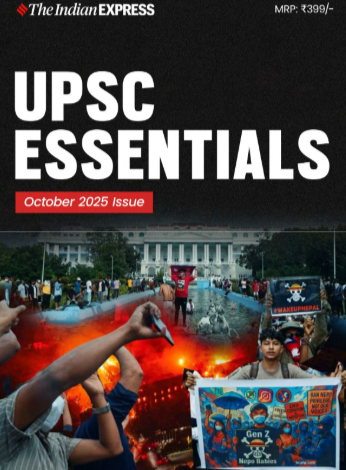(Relevance: The office of the Lokpal Act was passed in 2013 after massive public protests in the country. This anti-corruption body was provided with significant provisions to act as a watchdog. This makes it an important body and an important topic from your exam perspective.)

Why in the news?
Anti-corruption ombudsman Lokpal, currently a seven-member body headed by former Supreme Court judge Justice A M Khanwilkar, has floated a tender for the procurement of seven BMW cars, raising eyebrows.
Story continues below this ad
“The Lokpal of India invites open tenders from reputed agencies for supply of seven BMW 3 series 330Li cars to the Lokpal of India,” stated the tender issued on October 16. The tender was floated for the ‘M Sport’ model with ‘long wheelbase’, and in white colour.
Key takeaways:
1. The Lokpal is an independent anti-corruption authority in India, created to represent the public interest and hear cases of corruption against public officials connected with the Central government. It was established under the Lokpal and Lokayuktas Act, 2013, enacted by Parliament following the Jan Lokpal movement led by social activist Anna Hazare in 2010. India got its first Lokpal in 2019.
2. Under the 2013 Act, the Lokpal should consist of a chairperson and such number of members, not exceeding eight, of whom 50% should be judicial members. The Act states that not less than 50% of the members of the Lokpal should be from among persons belonging to the SCs, the STs, OBCs, minorities and women.
3. For states, the Act says: “Every State shall establish a body to be known as the Lokayukta for the State, if not so established, constituted or appointed, by a law made by the State Legislature, to deal with complaints relating to corruption against certain public functionaries, within a period of one year from the date of commencement of this Act.”
Story continues below this ad
4. Section 11 of the Act obligates the Lokpal to constitute an Inquiry Wing, headed by the Director of Inquiry, for the purpose of conducting preliminary inquiry into any offence alleged to have been committed by a public servant punishable under the Prevention of Corruption Act, 1988. The Director of Inquiry shall not be below the rank of Joint Secretary to the Government of India and is appointed by the Central Government for conducting preliminary inquiries referred to the Commission by the Lokpal.
5. It also has a Prosecution Wing, headed by the Director of Prosecution, for the purpose of prosecution of public servants in relation to any complaint by the Lokpal under this Act.
6. The jurisdiction of the Lokpal covers a wide range of public servants — from the Prime Minister, ministers and MPs, to groups A, B, C and D employees of the central government. Even Lokpal’s own members are under the definition of “public servant”.
7. In case of allegations or charges against the Prime Minister, there are certain conditions. Lokpal can’t inquire if the allegation against the Prime Minister relates to international relations, external and internal security, public order, atomic energy, and space. Also, complaints against the Prime Minister are not to be probed unless the full Lokpal bench considers the initiation of inquiry and at least 2/3rds of the members approve it.
Story continues below this ad
8. Such an inquiry against the Prime Minister (if conducted) is to be held in camera and if the Lokpal comes to the conclusion that the complaint deserves to be dismissed, the records of the inquiry are not to be published or made available to anyone.
9. The current Lokpal has seven members against a sanctioned strength of eight. Other than chairperson Justice Khanwilkar, its six members are former Chief Justice of Allahabad High Court Justice Sanjay Yadav; former Chief Justice of Karnataka High Court Ritu Raj Awasthi; former judge of Karnataka High Court Justice L Narayana Swamy; former Chief Election Commissioner Sushil Chandra; former Chief Secretary of Gujarat Pankaj Kumar; and former Secretary of Women and Child Development Ministry Ajay Tikrey.
10. Section 7 of the Lokpal act provides that the Salaries, allowances, and service conditions of the Lokpal chairperson is same as those for the Chief Justice of India; those for other members is same as those for a judge of the Supreme Court. Important to note that the Chief Justice of India is assigned a Mercedes while other Supreme Court judges are assigned BMW 3 series cars, the same for which the Lokpal has issued a tender.
BEYOND THE NUGGET: Origin of the institution of Ombusment
1. The institution of ombudsman originated in Sweden in 1809, and adopted by many nations as a bulwark of democratic government against the tyranny of officialdom. Ombudsman is a Swedish word that stands for an officer appointed by the legislature to handle complaints against administrative and judicial action.
Story continues below this ad
2. In India, the Administrative Reforms Commission (ARC),1966, first mooted the idea of a specialised institution called an ombudsman to redress citizens’ grievances and to fight corruption among politicians and within the government services. Two special authorities, Lokpal at the Central level and the Lokayukta at the state level, were introduced.
3. Bills seeking an ombudsman were introduced in Parliament eight times between 1968 and 2001 but were not passed. However, over the years, different states set up their own Lokayuktas — the state equivalent of the Lokpal. Maharashtra was first in this respect with its Lokayukta body established in 1971 under the Maharashtra Lokayukta and Upayukta Act.
Post Read Question
Consider the following statements about the Lokpal:
1. Justice Pinaki Chandra Ghose was the first Lokpal of India appointed in 2014.
Story continues below this ad
2. Lokpal has the power to inquire in case of allegations or charges against the Prime Minister involving international relations.
3. Members of Lokpal are included under the definition of “public servant”.
4. Salaries, allowances, and service conditions of the Lokpal chairperson are the same as those for the Chief Justice of India.
Which of the above-mentioned statements is/are correct?
(a) 1 and 2 only
(b) 3 and 4 only
(c) 1 and 3 only
(d) 2 and 4 only
(Sources: Explained: How Lokpal will form, function, Simply put: The search for a Lokpal, A brief history of Lokayukta: Maharashtra to Karnataka, evolution of anti-corruption watchdog)
Story continues below this ad
Subscribe to our UPSC newsletter. Stay updated with the latest UPSC articles by joining our Telegram channel – IndianExpress UPSC Hub, and follow us on Instagram and X.


































